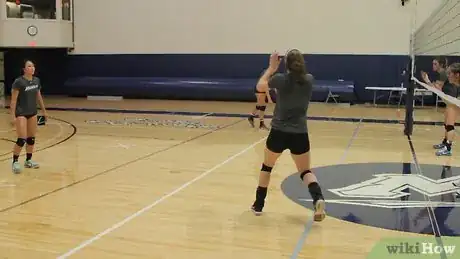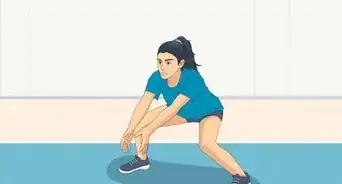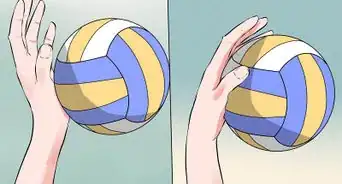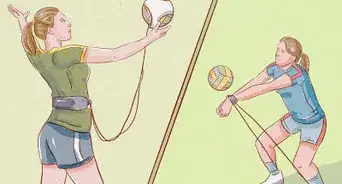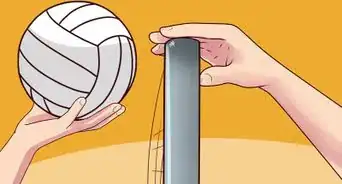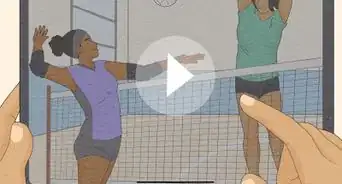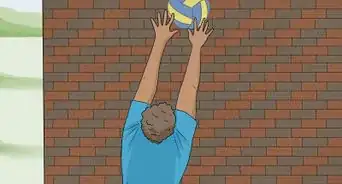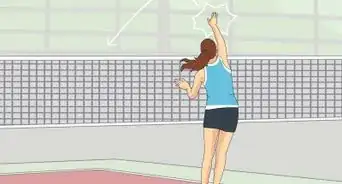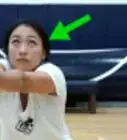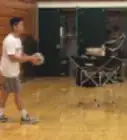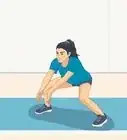wikiHow is a “wiki,” similar to Wikipedia, which means that many of our articles are co-written by multiple authors. To create this article, 76 people, some anonymous, worked to edit and improve it over time.
wikiHow marks an article as reader-approved once it receives enough positive feedback. This article has 14 testimonials from our readers, earning it our reader-approved status.
This article has been viewed 636,422 times.
Learn more...
In the game of volleyball, the set is a maneuver in which a player quickly makes contact with the ball in order to set up a spike for another player. Most good spikes are the result of a good set, i.e. one that accords with volleyball's rules against catching the ball, and that the attacker (the person doing the spiking) can predict and easily spike. This means that good setting must be, above all, consistent in overall style.[1] The maneuver itself is simple, but can be a difficult one to truly master.
Steps
Getting to the Ball
-
1Read the defense. Before the ball is even served, strategize about where you want the ball to go. Is one of their blockers less effective than another? Is there an obvious area they aren't guarding well? If so, you want to get to the ball to an attacker on your team who is positioned to make the best of that weakness.[2]
- Throughout play, try to continually assess the defense, so you always know where you want to send the ball when you have the opportunity.
-
2Be ready to move. When waiting for the ball to be passed, stand with your weight on your right foot, ready to take a step with your left in the direction of the ball. [3]
- Most setters find it easiest to position themselves in the back-right corner of the court and approach each set from there. You can set from wherever you are most comfortable, but this position starts you off facing in the optimal direction for sending the ball to your team's attackers.[4]
Advertisement -
3Get to the ball quickly. The ball will rarely come directly to you. The faster you get to it, the more time you have to execute the set.
- Getting quickly to the ball is all about efficiency. This means you should try to move in a straight line to the ball, taking no more steps than necessary.
- You will also need to run as efficiently as possible. Many setters make the mistake of running with their arms up, but this will slow you down. Wait to raise your arms until you are in position.[5]
-
4Square your body with the target. When you reach your position, make sure your hips, feet, and shoulders are directly facing the spot the ball is going to come down, not the direction it came from.
- A good rule of thumb is to always orient yourself toward the left antennae when setting, that way the other team can't figure out where you're going to set the ball to based on which way you are facing.[6]
Getting in Position
-
1Extend your arms up over your head. Your hands should be directly above your forehead and your elbows should be pointed to the sides.
-
2Position your hands. Your hands should be four to six inches above your forehead, with your fingers spread out in shape of the ball, as if someone were about to rest the ball in your hands.
- Your thumbs and forefingers should form a triangular window through which you can see the ball, but your hands should not actually touch one another.
- Try to relax your fingers right before you make contact with the ball.
- If you want to back set the ball, aiming it behind you, extend your arms upward and behind instead of in front or directly above you.
-
3Position your feet. Spread your feet about shoulder width apart, with the foot closest to the net slightly in front of the other. This position rotates your hips and shoulders slightly into the court and helps keep the set from accidentally going over the net.
-
4Bend your knees. Before you set, your knees should be slightly bent and your weight distributed evenly from the balls of your feet to the arches.
- Even distribution of weight will allow you to quickly change the direction you are facing if necessary.
- If you are back setting, the knee bend is less important. Instead, push your hips forward a little and slightly arch your back.
Setting the Ball
-
1Decide where to send the ball. You should already have developed some ideas about this, but this is your last chance to choose the right attacker to send the ball to.
- You can create advantageous situations for your team by being deceptive about where you are going to send the ball, potentially leaving the other team unprepared for which attacker will actually be spiking.[7]
- For example, you might slightly arch your back, as if you are going to back set, and then at the last second set the ball forward instead, or vice versa.
- You can also square up as if you are going to set the ball toward one player, especially one across the court, and instead execute a short set to an attacker in a different direction, such as off to your side.[8]
- After setting, turn and look toward the ball's final destination, to signal your own teammates.
-
2Make contact. Contact with the ball should occur just above the center of your forehead, roughly at your hairline.
- Try to make contact with all of your fingers touching the ball. The more of the ball's surface area you make contact with, the more control you will have over it.
- Do not let the ball touch your palms. Contact with your palms may be considered catching the ball, which is against the rules in volleyball. If your team scores a point after an illegal maneuver, the referee might opt to restart the rally and revoke that point.
-
3Push upwards. As soon as the ball touches your fingers, straighten your arms and legs as you push the ball upward in the direction of the spiker.
- The straightening of your legs sends power through your body and up to your hands. Your whole body should be part of the push.[9]
- Actual contact time with the ball should be minimal.
- This action is essentially the same for a back set, but with less force originating from the knees.
-
4Follow through. At the end of your set, your arms should be fully extended, and you should follow through with your hands by straightening your wrists after releasing the ball. This helps ensure that it stays on your intended trajectory.
Community Q&A
-
QuestionHow would I do a quick set without snapping my wrists too hard?
 Community AnswerTry to use your legs more, this will help get more power into your set without snapping your wrists as much.
Community AnswerTry to use your legs more, this will help get more power into your set without snapping your wrists as much. -
QuestionHow do I spike a volleyball?
 Community AnswerYou spike a volleyball by simply smacking the ball. You want your hand to wrap around the ball while spiking it so open up your fingers. As you're doing this you need to flick you wrist down so that the ball doesn't go flying up. In sum, measure the ball, stretch your arm ALL THE WAY UP, smack the ball with your fingers OPEN, and flick your wrist in a downwards motion.
Community AnswerYou spike a volleyball by simply smacking the ball. You want your hand to wrap around the ball while spiking it so open up your fingers. As you're doing this you need to flick you wrist down so that the ball doesn't go flying up. In sum, measure the ball, stretch your arm ALL THE WAY UP, smack the ball with your fingers OPEN, and flick your wrist in a downwards motion. -
QuestionShould I set the ball in front of or behind the attacker's hitting shoulder?
 Emily NewtonCommunity AnswerYou should set the ball right in front of them. If you set it behind the hitter’s shoulder, they will have to move in the middle of the attack, decreasing the power of the hit.
Emily NewtonCommunity AnswerYou should set the ball right in front of them. If you set it behind the hitter’s shoulder, they will have to move in the middle of the attack, decreasing the power of the hit.
Warnings
- When you follow through, do not snap your wrist. This can result in hand/wrist problems.⧼thumbs_response⧽
- Do not hit the ball with too much force or you may injure your fingers or hands.⧼thumbs_response⧽
- Although your hands should not touch each other while setting, if you have your hands too far apart the ball might hit you in the face. Your thumbs and index fingers should be as close together as possible without actually touching.⧼thumbs_response⧽
References
- ↑ http://www.strength-and-power-for-volleyball.com/volleyball-strategies-setting.html
- ↑ http://www.strength-and-power-for-volleyball.com/volleyball-strategies-setting.html
- ↑ http://www.strength-and-power-for-volleyball.com/volleyball-skills-setting.html
- ↑ http://www.strength-and-power-for-volleyball.com/volleyball-strategies-setting.html
- ↑ http://www.strength-and-power-for-volleyball.com/volleyball-skills-setting.html
- ↑ http://www.strength-and-power-for-volleyball.com/volleyball-skills-setting.html
- ↑ https://www.strength-and-power-for-volleyball.com/volleyball-strategies-setting.html
- ↑ https://www.coachup.com/resources/volleyball/tips-for-setters#close
- ↑ http://www.strength-and-power-for-volleyball.com/volleyball-skills-setting.html
About This Article
To set a volleyball, start by putting your arms above your head with your elbows pointed to the sides. Your hands should be about 6 inches away from your forehead. Then, keep your feet shoulder-width apart and bend your knees so you’re ready as the ball comes toward you. Make contact with the ball with all of your fingers and push it upward by straightening your arms and legs at the same time. For tips on how to get to the ball quickly, keep reading!
